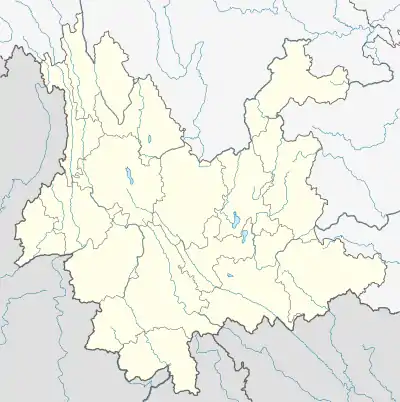Dashan Township
大山乡 | |
|---|---|
Etymology:
| |
 Dashan Township Location in Yunnan. | |
| Coordinates: 23°00′27″N 100°06′34″E / 23.00750°N 100.10944°E | |
| Country | People's Republic of China |
| Province | Yunnan |
| Prefecture-level city | Pu'er City |
| Autonomous county | Lancang Lahu Autonomous County |
| Incorporated (township) | 1988 |
| Area | |
| • Total | 233 km2 (90 sq mi) |
| Population (2017) | |
| • Total | 16,281 |
| • Density | 70/km2 (180/sq mi) |
| Time zone | UTC+08:00 (China Standard) |
| Postal code | 665600 |
| Area code | 0879 |
Dashan Township (simplified Chinese: 大山乡; traditional Chinese: 大山鄉; pinyin: Dàshān Xiāng) is a township in Lancang Lahu Autonomous County, Yunnan, China. As of the 2017 census it had a population of 16,281 and an area of 233-square-kilometre (90 sq mi).
Administrative division
As of 2016, the township is divided into eight villages:
- Dashan (大山村)
- Banpo (半坡村)
- Youzhafang (油榨房村)
- Pingtian (平田村)
- Manghai (芒海村)
- Tuanshan (团山村)
- Nanmei (南美村)
- Nandeba (南德坝村)
History
In the Republic of China, it belonged to the Banghai Township (邦海乡) and Daling Township (大岭乡).
After establishment of the Communist State, in 1950, the Dashan District (大山区) was set up. It was merged into Donghe District (东河区) in 1958. In 1984, Dashan District was demerged from Donghe District. It was incorporated officially as a township in 1988.
Geography
The township is located in northeastern Lancang Lahu Autonomous County.[1] It is surrounded by Jinggu Dai and Yi Autonomous County on the northeast, Fudong Township on the northwest, Qianliu Yi Ethnic Township on the southeast, and Donghe Township on the southwest.[1]
The highest point in the township is the Baishantoujian Mountain (白石头尖山) which stands 2,489 metres (8,166 ft) above sea level. The lowest point is Liangshuijing (凉水箐), which, at 750 metres (2,460 ft) above sea level.
The Manghai River (茫海河) flows through the township.
Economy
The township's economy is based on nearby mineral resources and agricultural resources. The main crops of the region are grains, followed by corns and wheat. Economic crops are mainly camellia oleifera, tea, castanea mollissima, and coffee bean. The region abounds with iron, manganese, tin, copper, lead, zinc, and limestone.
Demographics
| Year | Pop. | ±% |
|---|---|---|
| 2004 | 17,974 | — |
| 2017 | 16,281 | −9.4% |
| Source: [2] | ||
As of 2017, the National Bureau of Statistics of China estimates the township's population now to be 16,281.
| Ethnic groups in 2004[2] | ||
|---|---|---|
| Ethnicity | Population | Percentage |
| Lahu | 6275 | 34.9% |
| Han | 6170 | 34.3% |
| Wa | 421 | 2.3% |
| Yi | 4113 | 22.9% |
| Hui | 495 | 2.8% |
| Dai | 307 | 1.7% |
| Blang | 110 | 0.6% |
| Other | 83 | 0.5% |
References
- 1 2 Shi Chunyun 2007, p. 55.
- 1 2 Shi Chunyun 2007, p. 56.
Bibliography
- Shi Chunyun, ed. (2007). "Administrative divisions" 行政区划. 《澜沧拉祜族自治县概况》 [General Situation of Lancang Lahu Autonomous County] (in Chinese). Beijing: Nationalities Publishing House. ISBN 978-7-105-08556-9.